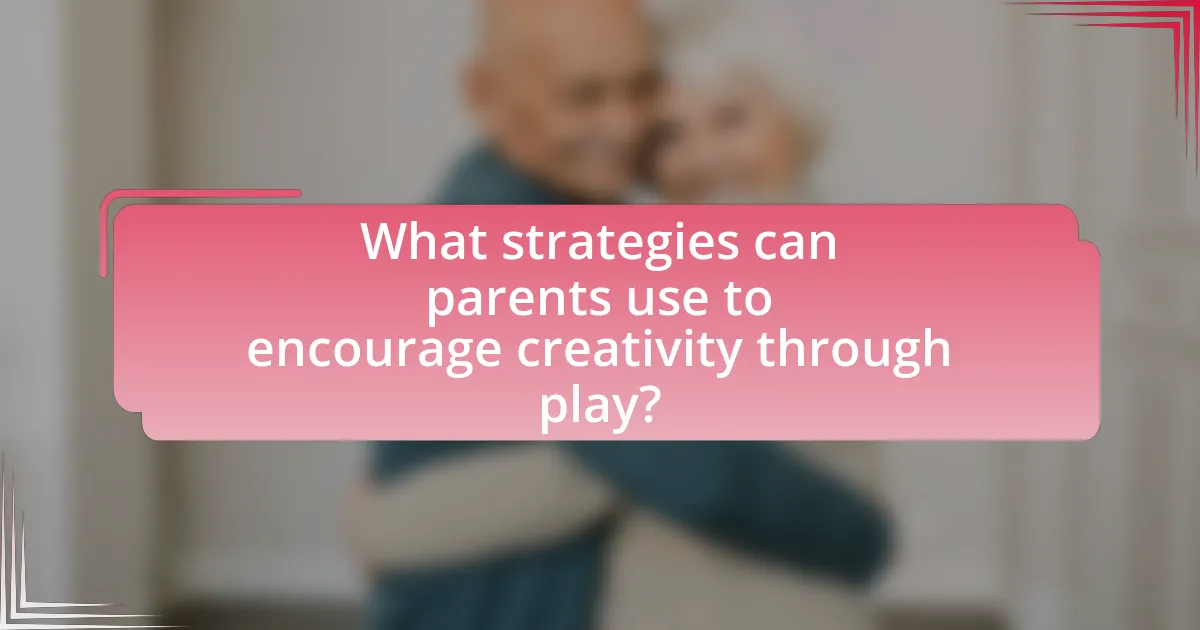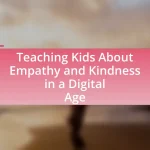The article focuses on how to support a child’s creativity through play, emphasizing the importance of various types of play, including imaginative, constructive, and exploratory play. It highlights research findings that demonstrate how unstructured play fosters creativity, problem-solving skills, and cognitive flexibility in children. The article also discusses strategies for parents to encourage creativity, such as providing open-ended materials, creating stimulating environments, and balancing structure with freedom in playtime. Additionally, it addresses common challenges in promoting creative play and offers practical tips for integrating creativity into everyday activities for different age groups.
How can play support a child’s creativity?
Play supports a child’s creativity by providing opportunities for exploration, experimentation, and self-expression. Engaging in play allows children to use their imagination, develop problem-solving skills, and think outside the box. Research indicates that unstructured play, such as imaginative role-playing or building with blocks, fosters divergent thinking, which is essential for creative development. A study published in the journal “Creativity Research Journal” by researchers from the University of Cambridge found that children who engage in free play exhibit higher levels of creativity compared to those who participate in structured activities. This evidence underscores the importance of play as a vital component in nurturing a child’s creative abilities.
What types of play foster creativity in children?
Types of play that foster creativity in children include imaginative play, constructive play, and exploratory play. Imaginative play, such as role-playing or storytelling, encourages children to create scenarios and characters, enhancing their ability to think abstractly. Constructive play, involving building with blocks or crafting, allows children to experiment with materials and design, promoting problem-solving skills. Exploratory play, which includes activities like nature walks or science experiments, encourages curiosity and discovery, leading to innovative thinking. Research indicates that these types of play are essential for cognitive development, as they stimulate neural connections and enhance creative thinking abilities in children.
How does imaginative play enhance creative thinking?
Imaginative play enhances creative thinking by allowing children to explore different scenarios, roles, and ideas in a safe environment. This type of play encourages cognitive flexibility, enabling children to think outside the box and develop innovative solutions to problems. Research indicates that children engaged in imaginative play demonstrate improved problem-solving skills and greater ability to generate unique ideas. For instance, a study published in the journal “Creativity Research Journal” found that children who participated in pretend play exhibited higher levels of creativity in tasks requiring divergent thinking, which is essential for creative problem-solving.
What role does physical play have in creative development?
Physical play significantly enhances creative development by providing children with opportunities to explore, experiment, and express themselves. Engaging in physical activities allows children to use their imagination, as they create scenarios and roles during play. Research indicates that children who participate in physical play demonstrate improved problem-solving skills and greater flexibility in thinking, which are essential components of creativity. For instance, a study published in the journal “Child Development” found that children who engage in active play are more likely to develop innovative thinking skills compared to those who do not. This connection between physical play and creative development underscores the importance of incorporating active play into children’s daily routines.
Why is creativity important for child development?
Creativity is crucial for child development as it fosters cognitive growth, emotional expression, and problem-solving skills. Engaging in creative activities allows children to explore their imagination, which enhances their ability to think critically and innovate. Research indicates that children who participate in creative play demonstrate improved social skills and emotional resilience, as they learn to navigate complex scenarios and express their feelings effectively. For instance, a study published in the journal “Child Development” by researchers at the University of California found that creative play significantly contributes to children’s ability to adapt to new situations and collaborate with peers.
How does creativity influence problem-solving skills?
Creativity enhances problem-solving skills by enabling individuals to generate diverse solutions and think outside conventional frameworks. When children engage in creative play, they develop cognitive flexibility, allowing them to approach problems from multiple angles. Research indicates that creative activities, such as imaginative play and artistic expression, foster critical thinking and innovation, which are essential for effective problem-solving. For instance, a study published in the journal “Creativity Research Journal” by Runco and Acar (2012) found that creative thinking is positively correlated with problem-solving abilities, demonstrating that individuals who practice creativity are better equipped to navigate complex challenges.
What are the long-term benefits of nurturing creativity?
Nurturing creativity leads to enhanced problem-solving skills, improved emotional intelligence, and greater adaptability in individuals. Research indicates that creative individuals are better equipped to approach challenges with innovative solutions, as evidenced by a study published in the Journal of Creative Behavior, which found that creativity correlates with higher levels of cognitive flexibility. Additionally, fostering creativity contributes to emotional well-being; a report from the American Psychological Association highlights that creative expression can reduce stress and anxiety, promoting mental health. Lastly, individuals who engage in creative activities often demonstrate increased resilience, allowing them to navigate life’s changes more effectively, as supported by findings from the National Endowment for the Arts, which show that creative engagement is linked to lifelong learning and adaptability.

What strategies can parents use to encourage creativity through play?
Parents can encourage creativity through play by providing open-ended materials and opportunities for imaginative exploration. Open-ended materials, such as blocks, art supplies, and natural objects, allow children to create without predefined outcomes, fostering innovation and problem-solving skills. Research indicates that children who engage in unstructured play demonstrate higher levels of creativity and cognitive flexibility, as noted in a study published in the journal “Creativity Research Journal” by researchers from the University of Cambridge. Additionally, parents can facilitate creative play by participating alongside their children, asking open-ended questions, and encouraging storytelling, which enhances their ability to think critically and express themselves.
How can parents create a stimulating play environment?
Parents can create a stimulating play environment by providing diverse materials and opportunities for exploration. This includes incorporating items such as building blocks, art supplies, and sensory materials that encourage creativity and problem-solving. Research indicates that environments rich in varied stimuli can enhance cognitive development and imaginative play, as supported by a study published in the journal “Child Development,” which found that children exposed to diverse play materials showed increased creativity and engagement. Additionally, allowing for open-ended play without strict guidelines fosters independence and innovation, further supporting a child’s creative growth.
What materials and resources are best for creative play?
The best materials and resources for creative play include open-ended items such as building blocks, art supplies, and natural materials. Building blocks, like LEGO or wooden blocks, encourage spatial awareness and problem-solving skills. Art supplies, including crayons, paints, and clay, foster self-expression and imagination. Natural materials, such as stones, leaves, and sticks, promote exploration and creativity in a tactile way. Research indicates that children who engage with diverse materials during play develop critical thinking and innovative skills, as supported by studies from the American Academy of Pediatrics, which emphasize the importance of unstructured play in child development.
How can parents balance structure and freedom in playtime?
Parents can balance structure and freedom in playtime by setting clear guidelines while allowing children the autonomy to explore within those boundaries. Establishing a routine that includes designated playtime encourages children to engage in creative activities, while providing options for different types of play—such as free play, guided play, and structured activities—supports their creativity. Research indicates that children benefit from a mix of both structured and unstructured play, as it fosters problem-solving skills and imaginative thinking. For instance, a study published in the journal “Child Development” highlights that children who experience a balance of structured and free play demonstrate greater cognitive flexibility and creativity.
What role does parental involvement play in creative play?
Parental involvement plays a crucial role in enhancing creative play among children. When parents actively engage in play, they provide emotional support, encouragement, and resources that stimulate a child’s imagination and creativity. Research indicates that children whose parents participate in their play activities demonstrate higher levels of creativity and problem-solving skills. For instance, a study published in the journal “Child Development” found that children with involved parents showed greater flexibility in thinking and originality in their play scenarios. This involvement not only fosters a supportive environment but also models creative behaviors, reinforcing the importance of exploration and innovation in play.
How can parents engage with their children during play?
Parents can engage with their children during play by actively participating in the activities, asking open-ended questions, and encouraging imaginative scenarios. Active participation allows parents to model behaviors and share experiences, which enhances the child’s engagement and creativity. For instance, when playing with blocks, a parent can build alongside the child, demonstrating different structures and encouraging the child to explore their own ideas. Research indicates that children who engage in play with responsive adults show higher levels of creativity and problem-solving skills, as highlighted in the study “The Role of Play in Child Development” by the American Academy of Pediatrics. This involvement not only strengthens the parent-child bond but also fosters an environment where creativity can flourish.
What are some ways to encourage independent play?
To encourage independent play, provide children with a variety of open-ended toys and materials that stimulate creativity, such as building blocks, art supplies, and imaginative play items. Research indicates that children who engage with open-ended materials develop problem-solving skills and creativity, as these resources allow for self-directed exploration and experimentation. Additionally, setting up a designated play area that is safe and inviting encourages children to engage in play independently, fostering autonomy and confidence.
What are common challenges in supporting a child’s creativity through play?
Common challenges in supporting a child’s creativity through play include limited resources, adult interference, and societal expectations. Limited resources, such as access to diverse materials and safe play environments, can hinder creative expression. Adult interference often manifests as over-structuring playtime, which restricts a child’s ability to explore and innovate independently. Societal expectations may pressure children to conform to specific norms, stifling their unique creative impulses. Research indicates that environments that encourage free play and exploration significantly enhance creativity in children, highlighting the importance of addressing these challenges.
How can parents overcome barriers to creative play?
Parents can overcome barriers to creative play by providing a supportive environment that encourages exploration and imagination. This can be achieved by setting aside dedicated time for unstructured play, minimizing distractions such as screens, and offering a variety of materials that stimulate creativity, such as art supplies, building blocks, and costumes. Research indicates that children who engage in creative play develop better problem-solving skills and emotional resilience, highlighting the importance of fostering such experiences. By actively participating in play and showing enthusiasm, parents can further enhance their child’s creative engagement, reinforcing the value of imaginative play in their development.
What are the effects of screen time on creativity?
Excessive screen time negatively impacts creativity by reducing opportunities for imaginative play and critical thinking. Research indicates that children who spend more than two hours a day on screens tend to exhibit lower levels of creative thinking and problem-solving skills. A study published in the journal “Creativity Research Journal” found that children engaged in unstructured play, which is often limited by screen time, demonstrate higher creativity levels compared to those who primarily consume digital content. This suggests that limiting screen time can foster an environment conducive to creative development.
How can parents address a child’s reluctance to engage in creative play?
Parents can address a child’s reluctance to engage in creative play by providing a supportive environment that encourages exploration and imagination. Creating a designated play space filled with diverse materials, such as art supplies, building blocks, and costumes, can stimulate interest. Research indicates that children are more likely to engage in creative activities when they feel safe and supported; for instance, a study published in the Journal of Creative Behavior found that children who have access to varied play materials exhibit higher levels of creativity. Additionally, parents can model creative play by participating alongside their child, demonstrating that play is enjoyable and valuable.
What are some practical tips for fostering creativity in everyday play?
To foster creativity in everyday play, provide open-ended materials such as blocks, art supplies, and costumes that encourage imaginative exploration. Research indicates that children who engage with versatile play materials develop problem-solving skills and creativity more effectively than those with limited options. For instance, a study by the American Academy of Pediatrics highlights that unstructured playtime allows children to express themselves and innovate, leading to enhanced cognitive development. Additionally, incorporating diverse environments, such as parks or community spaces, can stimulate new ideas and interactions, further promoting creative thinking.
How can parents incorporate creativity into routine activities?
Parents can incorporate creativity into routine activities by integrating imaginative play and open-ended tasks into daily chores. For example, while cooking, parents can encourage children to create their own recipes or invent stories about the ingredients, fostering both creativity and engagement. Research indicates that children who participate in creative activities during routine tasks develop better problem-solving skills and emotional intelligence, as highlighted in a study by the American Psychological Association. This approach not only makes mundane tasks enjoyable but also enhances children’s creative thinking and adaptability in various situations.
What are some fun, creative play ideas for different age groups?
Fun, creative play ideas vary by age group and can significantly enhance a child’s creativity. For infants (0-12 months), sensory play with textured toys and safe household items promotes exploration. Toddlers (1-3 years) benefit from imaginative play using dress-up clothes and simple role-playing games, which encourage creativity and social skills. Preschoolers (3-5 years) enjoy arts and crafts, such as finger painting or building with blocks, fostering fine motor skills and artistic expression. For school-aged children (6-12 years), engaging in storytelling or creating their own board games stimulates critical thinking and creativity. Finally, teenagers (13-18 years) can explore creative writing, music, or digital art, allowing them to express their individuality and develop their unique voice. These activities are supported by developmental psychology research, which emphasizes the importance of play in cognitive and emotional growth.














